Dr Vino's wine blog
wine talk that goes down easy
The carbon footprint of wine
I recently tasted the intense, fruit-forward Tikal, Amorio, 2005 (about $30; find this wine). Along with notes of dark berries, tobacco and toast, was there also a whiff of petroleum?
The wine’s oversized bottle complemented the flavor profile perfectly since the bottle weighed about as much empty as a regular bottle full. I pity the wine store clerk who has to lift a case of it.
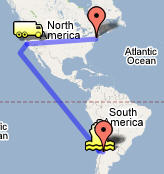 The heavy bottle took a long, meandering route to get to me in New York City. Starting out at the winery in Mendoza, Argentina, the wine’s American importer trucked it over the Andes to the port of San Antonio in Chile. There it loaded a boat and went to Oakland, CA. From there it came across country by truck to me in New York.
The heavy bottle took a long, meandering route to get to me in New York City. Starting out at the winery in Mendoza, Argentina, the wine’s American importer trucked it over the Andes to the port of San Antonio in Chile. There it loaded a boat and went to Oakland, CA. From there it came across country by truck to me in New York.
That’s a lot of carbon used to bring me this bottle of vino. But is it too much? At least the heavy bottle didn’t come by plane, which would have really jacked the petroleum per ounce of wine.
I was intrigued to read in the SF Chronicle that several restaurants have stopped serving (imported) bottled water because it is deemed too carbon inefficient.
Michael Pollan’s The Omnivore’s Dilemma prompted many eaters to think about the “carbon footprint” of their food and consider locally produced foods. Does that translate for you to your wine consumption?
The key issue for me is ease of substitution. I may be able to get water from local sources, but I can’t get any malbec locally. A tough call. Perhaps any eco guilt could be assuaged by buying carbon offsets?
Related:
“Local tap water bubbles up in restaurants” [SF Chronicle]
“Carbon neutral is hip, but is it green?” [NYT]
The Real Wine World
A couple of years ago I started a project that I called the Real Wine World. No, it didn’t involve locking three wine industry participants in a house and filming them 24 hours a day. Its goal was simply to follow a wine producer, a wine importer, and a wine retailer for a year to get a better look at how the wine biz works.
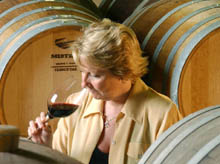 The participants were Susana Balbo in Argentina, Italian wine importer Gregory Smolik in Chicago, and the small shop Big Nose Full Body in Brooklyn’s Park Slope.
The participants were Susana Balbo in Argentina, Italian wine importer Gregory Smolik in Chicago, and the small shop Big Nose Full Body in Brooklyn’s Park Slope.
The reason I bring this up now is twofold. First, I have just transfered all the pieces over to this new site, posted to their original dates. You can find the lead-off piece here. And thanks to the new categories function, you can find all the pieces under The Real Wine World. The pieces now have space for your comments!
 Second, I thought I should bring closure to the project. Everyone got busy and the project didn’t make it the whole year. Susana Balbo had further demands on her time as she became president of the Wines of Argentina trade association. Gregory Smolik’s career as an independent importer of boutique wines from Italy came to an end but he now brings his passion and knowledge to his new job at the importer Domaine Select. Big Nose Full Body is still lubricating the palates of Park Slopers with free tastings on Saturday afternoons and 15% case discounts every day.
Second, I thought I should bring closure to the project. Everyone got busy and the project didn’t make it the whole year. Susana Balbo had further demands on her time as she became president of the Wines of Argentina trade association. Gregory Smolik’s career as an independent importer of boutique wines from Italy came to an end but he now brings his passion and knowledge to his new job at the importer Domaine Select. Big Nose Full Body is still lubricating the palates of Park Slopers with free tastings on Saturday afternoons and 15% case discounts every day.

Who knows, maybe we’ll try for a second season of the Real Wine World sometime?!
Where are the Americans in Argentina? What’s happening on Unfiltered?
Have you ever wondered why there are so few Americans in Argentina’s wine country while the French and Chileans seem to know their way around Mendoza? When I was there, I did. So I explored the issue in an article that appeared in the January issue of Wine Business Monthly, now available online.
Have you ever thought about how wineries use the internet to market wine? Or why sports fans are asking for “mas vino” instead of a nice cold one? Or whether Costco will make the three-tier system crumble? Then fire up your iTunes and listen to the most recent installment of “Unfiltered,” a podcast hosted by Tim Elliot of Winecast. I joined four others to taste wine and chew the fat. Oh no wait, since we were in four different time zones and connected via Skype, there was no imbibing (at least collectively), just talking.
Farmer fizz, for less
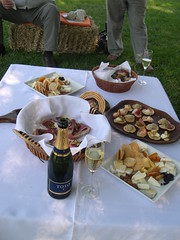 There’s a lot of talk these days about “grower champagnes,” sparkling wines made in the Champagne region by the grape growers themselves (see my backgrounder). In all the rush to talk about this farmer fizz, the fact that growers also make bubbly outside of Champagne sometimes gets lost.
There’s a lot of talk these days about “grower champagnes,” sparkling wines made in the Champagne region by the grape growers themselves (see my backgrounder). In all the rush to talk about this farmer fizz, the fact that growers also make bubbly outside of Champagne sometimes gets lost.
When I was in Argentina earlier this year, I tried some of the local bubbly. Moet controls the Argentine market for bubbly through its local subsidiary. In fact, their local label has risen to a level of brand awareness on par with Kleenex and Xerox. Instead of asking for a glass of “champagne” Argentines mostly ask for a glass of “Chandon.”
The sparkling wines made at the Mendoza Chandon winery serve many Latin American markets but don’t ever go north of Panama. Domaine Chandon in Napa provides American domestic sparklers to the US market alongside the Champagne brands in the LVMH portfolio such as Moet, Veuve Clicquot, and Krug.
In Argentina, Pascual Toso plays the Avis of the bubbly market to Moet’s Hertz. This family-owned company has been making wine since 1880 and now provides something like five percent of the bubbly to the Argentine domestic market. But unlike Chandon Argentina, which you would have to go there to taste, Toso brut is exported to the US. It is a blanc des blancs made of chardonnay and chenin blanc. If you’re looking for a bargain bubbly, to stock for a large party or simply for a break on the budget, the Toso retails for between $6-8 in the US (find this wine). Light in color, with notes of yeasty brioche, it’s some farmer fizz that will add bubbles to your budget.
Malbec match-up
How do winemaking and terroir affect malbec? We put this to the test recently with a leading wine from Argentina’s Mendoza region and the Cahors in France where the grape is also known as cot.
On my trip to Mendoza earlier this year, one of the most exciting wineries I visited was the Clos de los Siete project. Seven French investors, including many wine making families such as Rothschild (Lafite) and Cuvelier (Poyferré) joined forces under the teutalage of Michel Rolland, the “flying winemaker” par excellence who is also a stakeholder. They bought a vast plot of 850 heactares (over 2000 acres) in the Val de Uco at the base of the Andes and planted a small sea of vines, mostly malbec.
Each of the families either makes or will make their own wine but collectively they pool some grapes to make the Clos de los Siete wine, available for about $15 (Find this wine). This 2003 is mostly malbec but also includes some cabernet sauvignon, cabernet franc, and some syrah (!).
Against this wine, I poured blind the 2002 Clos la Coutale, which I bought in NYC for about $12 (Find this wine). From Cahors, the Clos La Coutale, a blend of mostly malbec with a little merlot and cab franc, is imported to the US by Kermit Lynch.
One wine exploded with rich aromas and flavors of violets, blackberries and tobacco from the glass. It had a round, soft complex mouthfeel and a good finish. The second wine was inky dark in color, and had a much more truncated flavor range with a certain tartness on the finish.
After the unveiling, wine #1 was the Clos de los Siete and wine #2 was the Cahors.
Although the malbec from Mendoza showed better that evening, a note of caution is necessary because of the 15 percent alcohol stated on the label. It’s big. The complexity would probably make a great BBQ wine for those tired of zinfandel.
This wine reminded me of a Cadillac Escalade: it’s fun to take it for a spin once, but who wants to own it and pay the gas bill? Drink too much of this one and you may be paying for it the next day.
* * * * *
Now in France, I found a bottle of the Clos la Coutale 2003 and tried it. The bottle showed much better–more full-bodied, more round, more complex, and even “bigger.” Pity I couldn’t taste this much better vintage against the Clos de los Siete. Especially since I got it for 7 euros ($8.90). Ah well, I’ll throw it in a future malbec match-up with some more wines from the two regions.
 tags: wine | malbec | wine tasting
tags: wine | malbec | wine tasting
Pascual Toso Malbec Reserve
Pascual Toso, Mendoza, Malbec reserve 2004. $13 find this wine
On my recent trip to Argentina, the jovial Ernesto Toso picked me up in his beat-up sedan and drove me from downtown Mendoza to his family winery in the Barrancas area, about 45 minutes. Overlooking a dry river bed that had channeled into the ground like a miniature Grand Canyon, I tasted the line of wines made at the winery with Paul Hobbs from Sonoma, California as consulting winemaker. The real sweet spot in terms of quality to price was the Malbec reserve with wonderful aromas of dark fruits and a hint of vanilla to complement a luscious mouthfeel and soft tannins. The straight malbec (about $8) is a good approximation but spring for the reserve if your budget permits. Fire up the grill and pull the cork! I also tried the $100 Magdalena 2002 (find this wine), which was no doubt a powerful and serious wine but at that lofty price point I couldn’t help but think about other wines I could have—or even nine bottles of the malbec reserve. Importer: TGIC imports.
 tags: wine | tasting notes | malbec
tags: wine | tasting notes | malbec
Sorbus, cabernet/malbec, 2004
Sorbus, cabernet/malbec, Mendoza, 2004. $6 find this wine
The other day a friend poured me some $6 Borsao, a wine that I discovered several years ago as a go-to value. Well, move over Borsao, here comes something meatier. A phenomenal value, this Sorbus displays the depth that a cab-malbec blend can give and has that same, crowd pleasing “ah” of the Ruca Malen Yauquen. I found it at PJ’s Wine in Manhattan for the bargain price of $5.97. This is one to buy by the case! Importer: Mediterranean Wine Co, Dover, NJ.
 tags: wine | tasting notes
tags: wine | tasting notes
Malbec, a backup or a star?
As I headed to Mendoza, I was haunted by a couple of sentences Eric Asimov recently wrote from a Wines of the Times tasting panel on Malbec:
“…words came readily enough to sum up the tasting — two-dimensional, narrow-gauge, simple. Nothing wrong with those words, but not very many thrills among them.”
Chilling stuff for the traveler to Malbec Country! I didn’t really understand what “two-dimensional†meant but it certainly sounded like damning with faint praise. When I was on the ground, I put the question to Manuel Louzada, winemaker at Domaine Chandon. His reply came with a sketch on his tasting mat, which I attempted to recreate here:
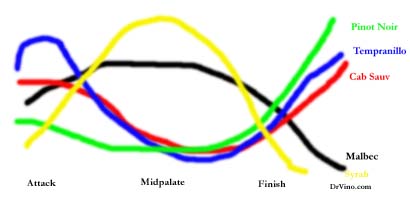
Essentially he said he could understand such a criticism because Malbec has a good attack and very good midpalate while it trails off at the finish. (If you think an attack is a military or a soccer term you’d be right; in wine tasting it also means how the wine tastes when it first enters your mouth—besides wet).
The other various arcs show the profile of other grapes. Tempranillo (blue, above) has a good attack, weaker midpalate, and a strong finish. Cabernet (red) has a similar arc he suggested but not quite as much on the attack. Syrah (yellow) has a broad midpalate but is kind of weak on the attack and the finish. Pinot Noir (green) has a finish that goes on and on—when done right.
This explains why some of the most expensive wines from the region are blends. The $70 Cheval des Andes 2003 (find this wine), perhaps my favorite of the big boy “grand cru†wines I tasted in Mendoza, is a blend of Malbec and Cab to give it a full style. Paul Hobbs added 5 percent Cab to his $100 Magadalena Toso (find this wine). And the $85 Nicolas Catena Zapata 2002 (find this wine) is a 72-28 blend of Cab and Malbec. This makes sense since Malbec has traditionally been a blender in Bordeaux and the Loire. Looking at the graphic above, a blend of the red and the black lines hits all the highs.
“The force of the Cabernet is softened by the Malbec,” José Galante winemaker at Catena said. “We make the best wine that we can in the Nicolás Catena Zapata.”
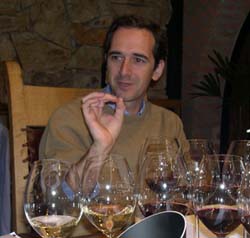
The various vineyard sites also have different tasting arcs for the same variety Galante said (see my notes on tasting Menodoza’s terroir). He works to blend those and give the single varietal wines more heft and character.
But what about Malbec on its own? “Malbec is sexy, it seduces,” said Manuel Louzada of Chandon. Indeed, this traditional backup singer is ready for a starring role. The prolonged growing season for the grapes in this high desert, which can have 50 percent more growing days than cool Bordeaux, makes the tannins in the Malbecs from Mendoza sweet and approachable. For white wine fans who object to the dryness or mouth-chomping tannins in Cabernet, reach for a Malbec from Argentina and you will not only have a wine that is easy on the palate but also easy on the wallet. If Malbec wines are two-dimensional, then the world is flat.



